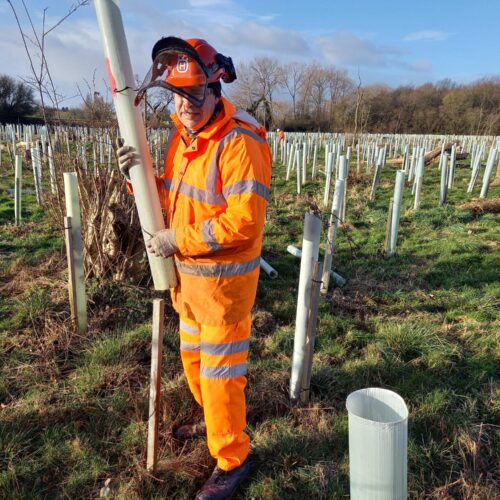Property owners who are affected by Japanese knotweed (Fallopia japonica) from adjoining land could sue for compensation, after a landmark ruling in Cardiff earlier this month.
Two homeowners in south Wales took a case to court after the notorious invasive weed reduced the value of their property. After four days of deliberations, the judge ruled in their favour: The company in question, a national rail company, was ordered to pay for treatment of the plants, plus an amount equivalent to the reduction in the property value as a consequence of the infestation. The rail company was refused immediate leave to appeal, but may choose to take the case to the high court.
The consequences of this ruling could cost the company millions. Whilst they do control Japanese knotweed, funds are usually prioritised for maintenance which is considered essential for the safe operation of the railway. The cost of controlling a prolific and widespread invasive weed across such a large area would be immense. For perspective, it was reported that the control of just 10 acres of Japanese Knotweed at the Olympic site in 2012 cost £70 million.
Japanese knotweed was introduced to Europe from Japan in the 1850s by a German horticulturalist who had discovered it growing on the sides of volcanoes near Nagasaki. It was soon being cultivated and sold by an increasing number of nurseries. It gained popularity throughout British gardens due to its ability to thrive, even when planted in harsh environments. The sharing of cuttings and dumping of unwanted specimens coupled with the lack of natural predators meant that the species quickly spread throughout the UK.
It was not until after the plant was widely established, that its destructive nature became apparent. According to various sources, £166 million is spent on Japanese knotweed control annually, and a further £1.5 billion would be required to control it nationwide.
The prolific growth rates (up to four meters in just 10 weeks) are fuelled by an extensive root system. The roots can extend to a depth of three meters in the soil and up to seven meters horizontally. The roots can force themselves through existing weaknesses into bricks and concrete which can damage drains and undermine the integrity of building foundations.
The seriousness of Japanese knotweed infestations is emphasised by the fact that some mortgage companies will not lend to individuals with Japanese knotweed on their properties. As a result, a Japanese knotweed infestation can cause a considerable impact on the value of a property.
The control of Japanese knotweed is not always a simple task as it can remain dormant for up to 20 years and can regrow from roots and rhizomes as small as the size of a fingernail. Control methods may include chemical treatment and/or excavation of the contaminated ground. Excavated material may be burnt, buried or taken to an offsite facility. It is important to note that if an offsite facility is used, it must have a permit to take Japanese knotweed and a registered waste carrier must be used to transport it. Unlawful transport or dumping of the invasive weed could result in a criminal conviction, including a fine or prison sentence.
If you are concerned that you may have Japanese knotweed on your property, it is best to seek expert advice. Thomson Habitats has a team of professional staff with extensive experience of consulting on, managing and monitoring sites with Japanese knotweed infestations. Our company is RISQS accredited and our staff are PTS certified.











